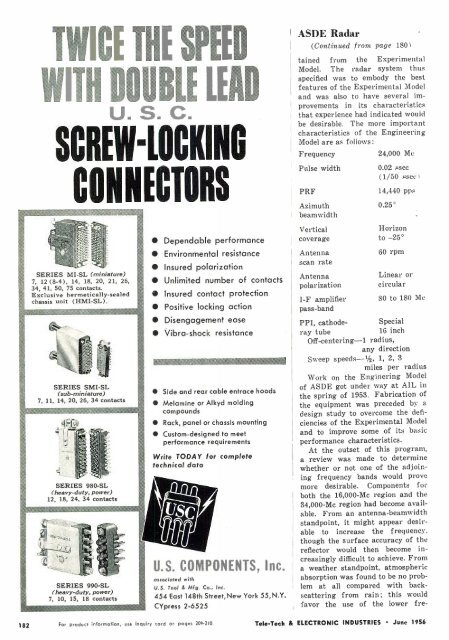TELE-TECH & - AmericanRadioHistory.Com
TELE-TECH & - AmericanRadioHistory.Com
TELE-TECH & - AmericanRadioHistory.Com
Create successful ePaper yourself
Turn your PDF publications into a flip-book with our unique Google optimized e-Paper software.
TWICE THE SPEED<br />
WITH DOUBLE LEAD<br />
SCREW-LOCKING<br />
CONNECTORS<br />
SERIES MI -SL (miniature)<br />
7, 12 (8 -4), 14, 18, 20, 21, 26,<br />
34, 41, 50, 75 contacts.<br />
Exclusive hermetically -sealed<br />
chassis unit (HMI -SL).<br />
SERIES SMI -SL<br />
(sub -miniature)<br />
7, 11, 14, 20, 26, 34 contacts<br />
SERIES 980 -SL<br />
(heavy -duty, power)<br />
12, 18, 24, 34 contacts<br />
SERIES 990 -SL<br />
(heavy -duty, power)<br />
7, 10, 15, 18 contacts<br />
Dependable performance<br />
Environmental resistance<br />
Insured polarization<br />
Unlimited number of contacts<br />
Insured contact protection<br />
Positive locking action<br />
Disengagement ease<br />
Vibra -shock resistance<br />
Side and rear cable entrace hoods<br />
Melamine or Alkyd molding<br />
compounds<br />
Rack, panel or chassis mounting<br />
Custom -designed to meet<br />
performance requirements<br />
Write TODAY for complete<br />
technical data<br />
U.S. COMPONENTS, Inc.<br />
associated with<br />
U.S. Tool 8 Mfg. Co., Inc.<br />
454 East 148th Street, New York 55,N.Y<br />
CYpress 2 -6525<br />
ASDE Radar<br />
(Continued from page 180)<br />
tained from the Experimental<br />
Model. The radar system thus<br />
specified was to embody the best<br />
features of the Experimental Model<br />
and was also to have several improvements<br />
in its characteristics<br />
that experience had indicated would<br />
be desirable. The more important<br />
characteristics of the Engineering<br />
Model are as follows:<br />
Frequency<br />
24,000 Mc<br />
Pulse width<br />
PRF<br />
Azimuth<br />
beamwidth<br />
Vertical<br />
coverage<br />
Antenna<br />
scan rate<br />
Antenna<br />
polarization<br />
I -F amplifier<br />
pass -band<br />
PPI, cathoderay<br />
tube<br />
0.02 sec<br />
(1/50 µsec)<br />
14,440 pps<br />
0.25°<br />
Horizon<br />
to 25°<br />
60 rpm<br />
Linear or<br />
circular<br />
80 to 180 Mc<br />
Special<br />
16 inch<br />
Off- centering -1 radius,<br />
any direction<br />
Sweep speeds -1 /2, 1, 2, 3<br />
miles per radius<br />
Work on the Enginering Model<br />
of ASDE got under way at AIL in<br />
the spring of 1953. Fabrication of<br />
the equipment was preceded by a<br />
design study to overcome the deficiencies<br />
of the Experimental Model<br />
and to improve some of its basic<br />
performance characteristics.<br />
At the outset of this program,<br />
a review was made to determine<br />
whether or not one of the adjoining<br />
frequency bands would prove<br />
more desirable. <strong>Com</strong>ponents for<br />
both the 16,000 -Mc region and the<br />
34,000 -Mc region had become available.<br />
From an antenna -beamwidth<br />
standpoint, it might appear desirable<br />
to increase the frequency,<br />
though the surface accuracy of the<br />
reflector would then become increasingly<br />
difficult to achieve. From<br />
a weather standpoint, atmospheric<br />
absorption was found to be no problem<br />
at all compared with back -<br />
scattering from rain; this would<br />
favor the use of the lower fre-<br />
182<br />
For product information, use inquiry cord on pages 209 -210.<br />
Tele -Tech & ELECTRONIC INDUSTRIES June 1956
















